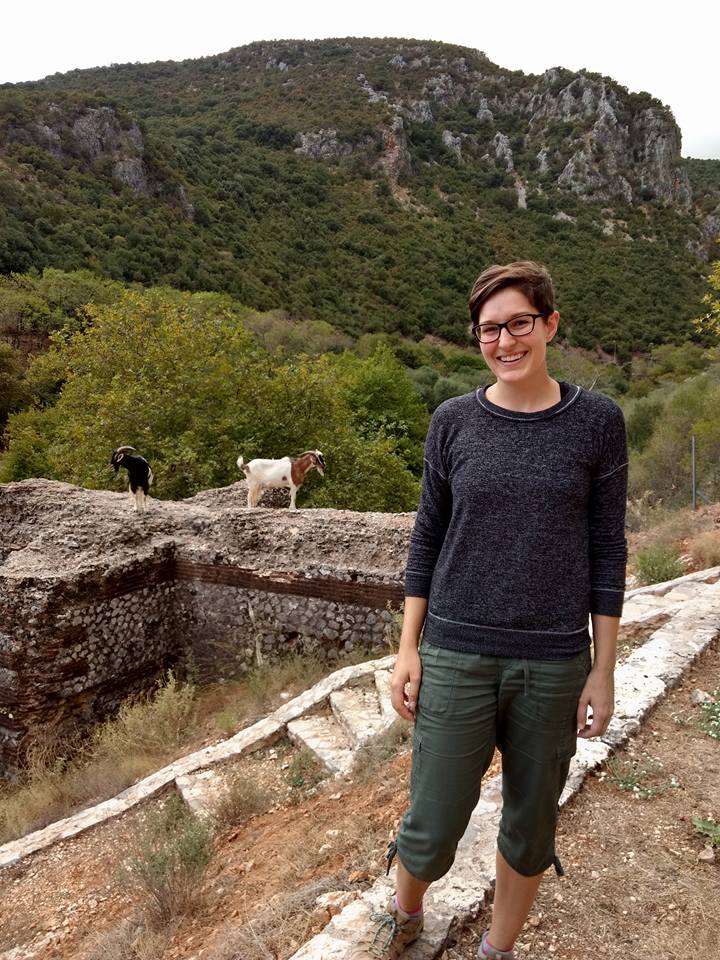
A Snapshot into Roman Dining at the Athenian Agora: An Interview with Sarah Beal
“We have this brief window in the post-Herulian destruction of the 3rd century CE where Athenian pottery production is almost entirely local. By this nature, perhaps the material is even more reflective of local dining practice. It’s something that is still new to being studied making it very exciting pottery to work with.”
Sarah Beal first heard about the American School during her Ph.D. interview at the University of Cincinnati, Ohio. “I had never worked in Greece before, but I was interested in possibly doing my dissertation there,” explained Beal. “So, once I heard about Cincinnati’s support and encouragement of the American School I knew I wanted to attend as a Regular Member.” Fast forward five years and Beal is now an Associate Member compiling material at the Ancient Athenian Agora for her dissertation.
Beal (left) and ASCSA Associate Member Janelle Sadarananda participating in a pottery workshop at the Ancient Athenian Agora.
After a walk each morning from Loring Hall to the Stoa of Attalos, Beal spends her time in the building’s basement storerooms flipping through archival notebooks and determining which excavated material to collect. “Right now, I’m using the archival notebooks to try and understand the 1930s-1950s Agora excavations. More specifically, where the domestic spaces are and what they found,” detailed Beal. “As I proceed, and especially in the spring, my focus will be looking at the material I’m interested in for my dissertation, the context pottery.”
Dating to the Herulian destruction layer of the mid-3rd century CE, the context pottery allows for distinctive insight into the lives of Athenians under Roman occupation. “In 267 CE, a tribe of barbarians comes through Athens and destroys the city,” explained Beal. “At that point, the original Greek agora lies outside the defenses of the city and becomes a forgotten space. A lot of the houses suffer and seemed to be abandoned during the actual invasion without ever being reoccupied. This material then gives us a really unique snapshot into what life was like at that specific moment in time.”
Titled, From Symposium to Convivium? Social Life in Roman Athens, Beal’s dissertation aims to understand Roman dining as an indicator for social practice within domestic contexts of the Agora. “What I’m interested in is what a dining event would have looked like for an Athenian during the Roman period,” said Beal. “I’m looking at ratios between vessels and determining whether people are eating from individual or communal plates. If there are communal plates that creates a sense of equality amongst all of the diners and says something very different than an individual plate, which can allow for social hierarchies to come into play.”

Beal visiting the Roman aqueduct at Nikopolis.
Experiencing Roman Athens as a Regular Member
As a Regular Member during the 2017-2018 academic year, Beal remembers being in awe at the depth in which the program explores Greece. “Before each trip in the fall, we would receive a list of sites and half of them I’d never heard of before! I found that very exciting and the whole experience was extremely eye opening to learn just how much is out there,” recalled Beal. One of her favorite sites was visiting the Cipollino quarries in Euboea. “Cipollino is a greenish marble used heavily during the Roman Empire. My M.A. thesis was on sarcophagi, production, and the marble trade. It was mind blowing seeing the quarries in person during that trip and I loved that it came full circle for me.”
Beal continued her study of Roman Greece throughout her Regular Member fellowship, specifically in a project she conducted in Ancient Corinth. “When we visited Ancient Corinth, I had the opportunity to meet Kathleen Slane, who studies Roman pottery. I was grateful as she immediately took me under her wing and invited me to come back for a weekend in the spring to show me everything they have in the museum storerooms,” said Beal. Working in Ancient Corinth’s museum during the Regular Year Program’s third semester, Beal spent her time examining the Roman pottery collection and providing additional information into the database. “All of the Roman pottery in Corinth is inventoried and has an inventory number, however, most do not have descriptive information. For example, details on the potter fabrics and forms. It was a really useful exercise for me to develop skills of identifying Roman pottery and also to make the information available for future researchers.”
Beal working the Archaeological Museum of Ancient Corinth, spring 2018.
In addition to her research, Beal is passionate about educational outreach of the Classical world. “I’ve been very involved in the outreach program at Cincinnati where we visit elementary schools, high schools, retirement homes, and libraries. I present two topics, one on gladiators and one of the archaeology of the Trojan War,” expressed Beal. “It’s an opportunity to get people excited about what we do and personally, it hits home for me when I speak to young students. I didn’t know majoring in Classics was an option when I was taking Latin in high school and to show them it’s a possibility has been really important to me.”